Mental Health Assessment: A Case Study Analysis of Samira's Trauma
VerifiedAdded on 2023/06/12
|10
|3490
|228
Case Study
AI Summary
This case study examines the mental health challenges faced by Samira, a 39-year-old woman dealing with grief, cultural transition, and family responsibilities following her husband's death. The analysis explores various social, psychological, cultural, and environmental risk factors affecting her well-being, including the loss of her husband, dysfunctional family life, negative thoughts, cultural differences, exposure to violence, and feelings of loneliness. The study also emphasizes the importance of protective factors such as social support and coping mechanisms in mitigating these risks. The discussion highlights the need for culturally sensitive healthcare, community-based mental health programs, and adequate support systems to address the complex needs of vulnerable populations like Samira. Desklib offers similar case studies and resources for students.

[Document title]
Name
[Course title]
[Date]
Name
[Course title]
[Date]
Paraphrase This Document
Need a fresh take? Get an instant paraphrase of this document with our AI Paraphraser
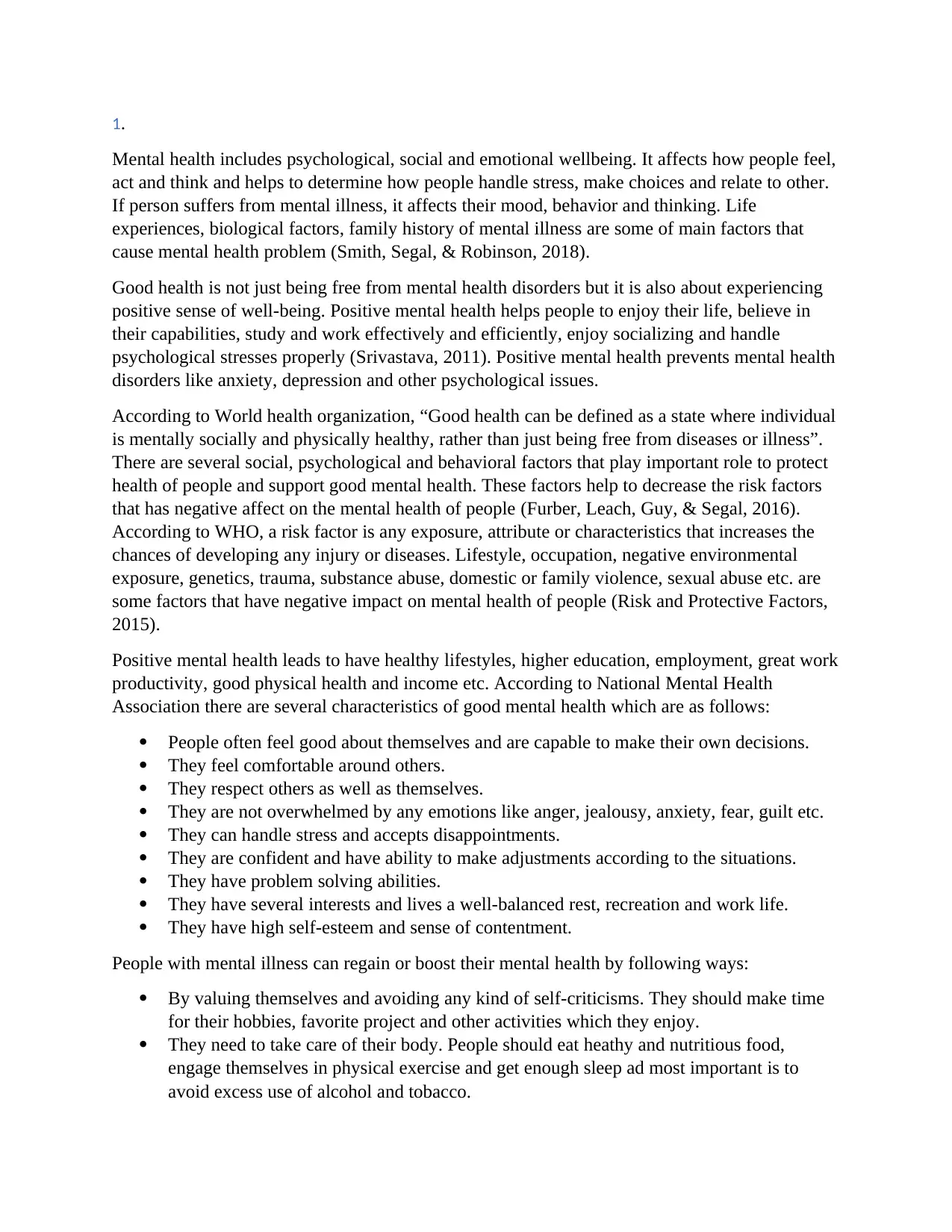
1.
Mental health includes psychological, social and emotional wellbeing. It affects how people feel,
act and think and helps to determine how people handle stress, make choices and relate to other.
If person suffers from mental illness, it affects their mood, behavior and thinking. Life
experiences, biological factors, family history of mental illness are some of main factors that
cause mental health problem (Smith, Segal, & Robinson, 2018).
Good health is not just being free from mental health disorders but it is also about experiencing
positive sense of well-being. Positive mental health helps people to enjoy their life, believe in
their capabilities, study and work effectively and efficiently, enjoy socializing and handle
psychological stresses properly (Srivastava, 2011). Positive mental health prevents mental health
disorders like anxiety, depression and other psychological issues.
According to World health organization, “Good health can be defined as a state where individual
is mentally socially and physically healthy, rather than just being free from diseases or illness”.
There are several social, psychological and behavioral factors that play important role to protect
health of people and support good mental health. These factors help to decrease the risk factors
that has negative affect on the mental health of people (Furber, Leach, Guy, & Segal, 2016).
According to WHO, a risk factor is any exposure, attribute or characteristics that increases the
chances of developing any injury or diseases. Lifestyle, occupation, negative environmental
exposure, genetics, trauma, substance abuse, domestic or family violence, sexual abuse etc. are
some factors that have negative impact on mental health of people (Risk and Protective Factors,
2015).
Positive mental health leads to have healthy lifestyles, higher education, employment, great work
productivity, good physical health and income etc. According to National Mental Health
Association there are several characteristics of good mental health which are as follows:
People often feel good about themselves and are capable to make their own decisions.
They feel comfortable around others.
They respect others as well as themselves.
They are not overwhelmed by any emotions like anger, jealousy, anxiety, fear, guilt etc.
They can handle stress and accepts disappointments.
They are confident and have ability to make adjustments according to the situations.
They have problem solving abilities.
They have several interests and lives a well-balanced rest, recreation and work life.
They have high self-esteem and sense of contentment.
People with mental illness can regain or boost their mental health by following ways:
By valuing themselves and avoiding any kind of self-criticisms. They should make time
for their hobbies, favorite project and other activities which they enjoy.
They need to take care of their body. People should eat heathy and nutritious food,
engage themselves in physical exercise and get enough sleep ad most important is to
avoid excess use of alcohol and tobacco.
Mental health includes psychological, social and emotional wellbeing. It affects how people feel,
act and think and helps to determine how people handle stress, make choices and relate to other.
If person suffers from mental illness, it affects their mood, behavior and thinking. Life
experiences, biological factors, family history of mental illness are some of main factors that
cause mental health problem (Smith, Segal, & Robinson, 2018).
Good health is not just being free from mental health disorders but it is also about experiencing
positive sense of well-being. Positive mental health helps people to enjoy their life, believe in
their capabilities, study and work effectively and efficiently, enjoy socializing and handle
psychological stresses properly (Srivastava, 2011). Positive mental health prevents mental health
disorders like anxiety, depression and other psychological issues.
According to World health organization, “Good health can be defined as a state where individual
is mentally socially and physically healthy, rather than just being free from diseases or illness”.
There are several social, psychological and behavioral factors that play important role to protect
health of people and support good mental health. These factors help to decrease the risk factors
that has negative affect on the mental health of people (Furber, Leach, Guy, & Segal, 2016).
According to WHO, a risk factor is any exposure, attribute or characteristics that increases the
chances of developing any injury or diseases. Lifestyle, occupation, negative environmental
exposure, genetics, trauma, substance abuse, domestic or family violence, sexual abuse etc. are
some factors that have negative impact on mental health of people (Risk and Protective Factors,
2015).
Positive mental health leads to have healthy lifestyles, higher education, employment, great work
productivity, good physical health and income etc. According to National Mental Health
Association there are several characteristics of good mental health which are as follows:
People often feel good about themselves and are capable to make their own decisions.
They feel comfortable around others.
They respect others as well as themselves.
They are not overwhelmed by any emotions like anger, jealousy, anxiety, fear, guilt etc.
They can handle stress and accepts disappointments.
They are confident and have ability to make adjustments according to the situations.
They have problem solving abilities.
They have several interests and lives a well-balanced rest, recreation and work life.
They have high self-esteem and sense of contentment.
People with mental illness can regain or boost their mental health by following ways:
By valuing themselves and avoiding any kind of self-criticisms. They should make time
for their hobbies, favorite project and other activities which they enjoy.
They need to take care of their body. People should eat heathy and nutritious food,
engage themselves in physical exercise and get enough sleep ad most important is to
avoid excess use of alcohol and tobacco.
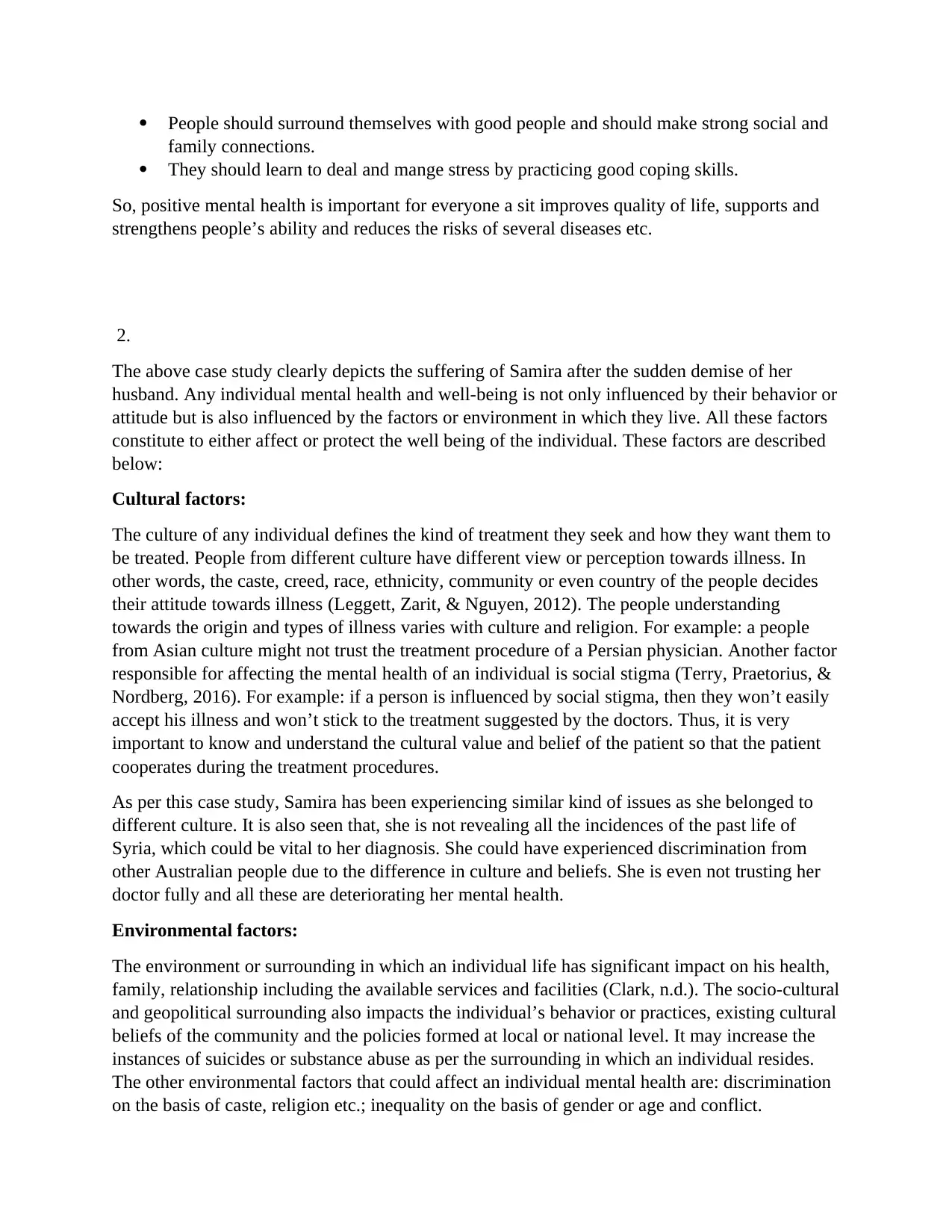
People should surround themselves with good people and should make strong social and
family connections.
They should learn to deal and mange stress by practicing good coping skills.
So, positive mental health is important for everyone a sit improves quality of life, supports and
strengthens people’s ability and reduces the risks of several diseases etc.
2.
The above case study clearly depicts the suffering of Samira after the sudden demise of her
husband. Any individual mental health and well-being is not only influenced by their behavior or
attitude but is also influenced by the factors or environment in which they live. All these factors
constitute to either affect or protect the well being of the individual. These factors are described
below:
Cultural factors:
The culture of any individual defines the kind of treatment they seek and how they want them to
be treated. People from different culture have different view or perception towards illness. In
other words, the caste, creed, race, ethnicity, community or even country of the people decides
their attitude towards illness (Leggett, Zarit, & Nguyen, 2012). The people understanding
towards the origin and types of illness varies with culture and religion. For example: a people
from Asian culture might not trust the treatment procedure of a Persian physician. Another factor
responsible for affecting the mental health of an individual is social stigma (Terry, Praetorius, &
Nordberg, 2016). For example: if a person is influenced by social stigma, then they won’t easily
accept his illness and won’t stick to the treatment suggested by the doctors. Thus, it is very
important to know and understand the cultural value and belief of the patient so that the patient
cooperates during the treatment procedures.
As per this case study, Samira has been experiencing similar kind of issues as she belonged to
different culture. It is also seen that, she is not revealing all the incidences of the past life of
Syria, which could be vital to her diagnosis. She could have experienced discrimination from
other Australian people due to the difference in culture and beliefs. She is even not trusting her
doctor fully and all these are deteriorating her mental health.
Environmental factors:
The environment or surrounding in which an individual life has significant impact on his health,
family, relationship including the available services and facilities (Clark, n.d.). The socio-cultural
and geopolitical surrounding also impacts the individual’s behavior or practices, existing cultural
beliefs of the community and the policies formed at local or national level. It may increase the
instances of suicides or substance abuse as per the surrounding in which an individual resides.
The other environmental factors that could affect an individual mental health are: discrimination
on the basis of caste, religion etc.; inequality on the basis of gender or age and conflict.
family connections.
They should learn to deal and mange stress by practicing good coping skills.
So, positive mental health is important for everyone a sit improves quality of life, supports and
strengthens people’s ability and reduces the risks of several diseases etc.
2.
The above case study clearly depicts the suffering of Samira after the sudden demise of her
husband. Any individual mental health and well-being is not only influenced by their behavior or
attitude but is also influenced by the factors or environment in which they live. All these factors
constitute to either affect or protect the well being of the individual. These factors are described
below:
Cultural factors:
The culture of any individual defines the kind of treatment they seek and how they want them to
be treated. People from different culture have different view or perception towards illness. In
other words, the caste, creed, race, ethnicity, community or even country of the people decides
their attitude towards illness (Leggett, Zarit, & Nguyen, 2012). The people understanding
towards the origin and types of illness varies with culture and religion. For example: a people
from Asian culture might not trust the treatment procedure of a Persian physician. Another factor
responsible for affecting the mental health of an individual is social stigma (Terry, Praetorius, &
Nordberg, 2016). For example: if a person is influenced by social stigma, then they won’t easily
accept his illness and won’t stick to the treatment suggested by the doctors. Thus, it is very
important to know and understand the cultural value and belief of the patient so that the patient
cooperates during the treatment procedures.
As per this case study, Samira has been experiencing similar kind of issues as she belonged to
different culture. It is also seen that, she is not revealing all the incidences of the past life of
Syria, which could be vital to her diagnosis. She could have experienced discrimination from
other Australian people due to the difference in culture and beliefs. She is even not trusting her
doctor fully and all these are deteriorating her mental health.
Environmental factors:
The environment or surrounding in which an individual life has significant impact on his health,
family, relationship including the available services and facilities (Clark, n.d.). The socio-cultural
and geopolitical surrounding also impacts the individual’s behavior or practices, existing cultural
beliefs of the community and the policies formed at local or national level. It may increase the
instances of suicides or substance abuse as per the surrounding in which an individual resides.
The other environmental factors that could affect an individual mental health are: discrimination
on the basis of caste, religion etc.; inequality on the basis of gender or age and conflict.
⊘ This is a preview!⊘
Do you want full access?
Subscribe today to unlock all pages.

Trusted by 1+ million students worldwide
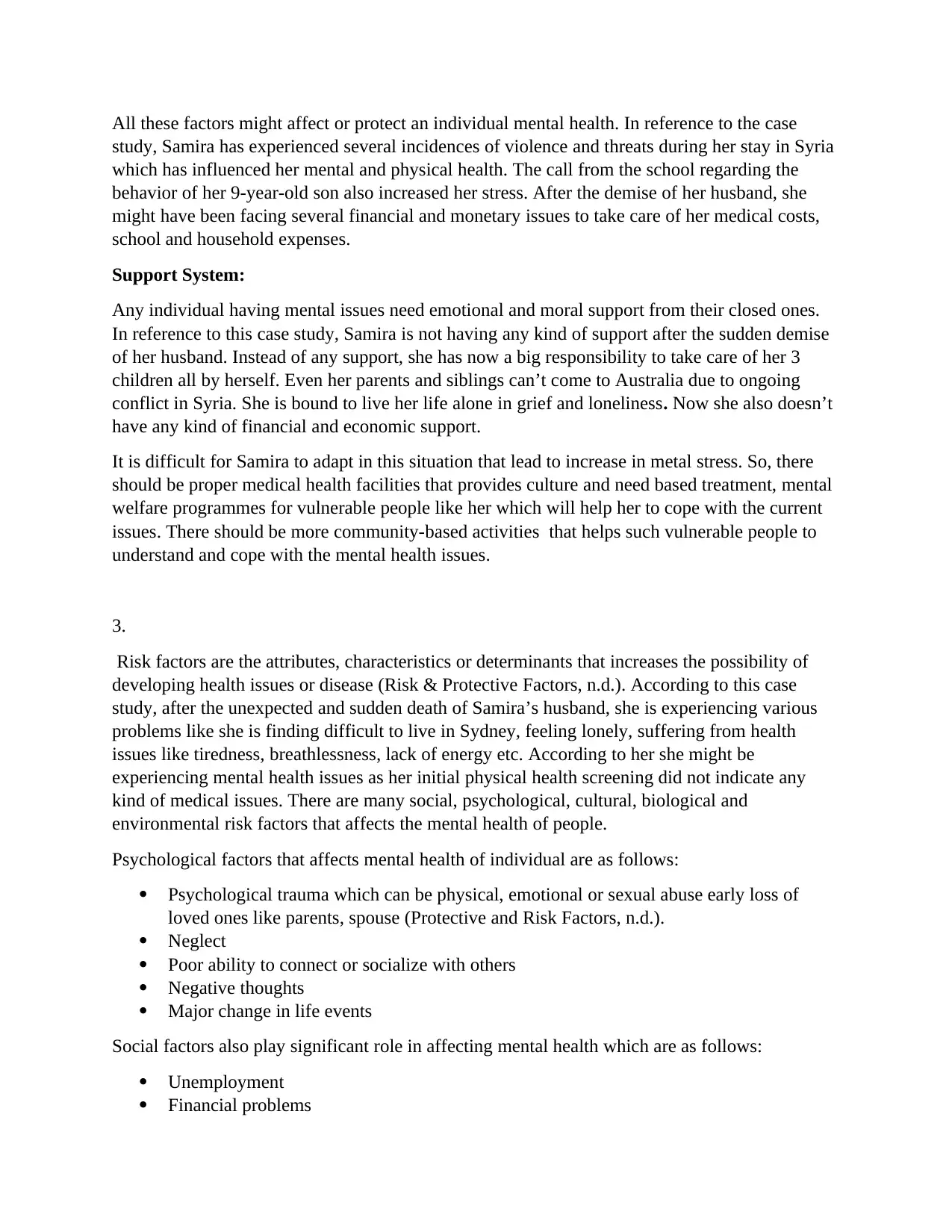
All these factors might affect or protect an individual mental health. In reference to the case
study, Samira has experienced several incidences of violence and threats during her stay in Syria
which has influenced her mental and physical health. The call from the school regarding the
behavior of her 9-year-old son also increased her stress. After the demise of her husband, she
might have been facing several financial and monetary issues to take care of her medical costs,
school and household expenses.
Support System:
Any individual having mental issues need emotional and moral support from their closed ones.
In reference to this case study, Samira is not having any kind of support after the sudden demise
of her husband. Instead of any support, she has now a big responsibility to take care of her 3
children all by herself. Even her parents and siblings can’t come to Australia due to ongoing
conflict in Syria. She is bound to live her life alone in grief and loneliness. Now she also doesn’t
have any kind of financial and economic support.
It is difficult for Samira to adapt in this situation that lead to increase in metal stress. So, there
should be proper medical health facilities that provides culture and need based treatment, mental
welfare programmes for vulnerable people like her which will help her to cope with the current
issues. There should be more community-based activities that helps such vulnerable people to
understand and cope with the mental health issues.
3.
Risk factors are the attributes, characteristics or determinants that increases the possibility of
developing health issues or disease (Risk & Protective Factors, n.d.). According to this case
study, after the unexpected and sudden death of Samira’s husband, she is experiencing various
problems like she is finding difficult to live in Sydney, feeling lonely, suffering from health
issues like tiredness, breathlessness, lack of energy etc. According to her she might be
experiencing mental health issues as her initial physical health screening did not indicate any
kind of medical issues. There are many social, psychological, cultural, biological and
environmental risk factors that affects the mental health of people.
Psychological factors that affects mental health of individual are as follows:
Psychological trauma which can be physical, emotional or sexual abuse early loss of
loved ones like parents, spouse (Protective and Risk Factors, n.d.).
Neglect
Poor ability to connect or socialize with others
Negative thoughts
Major change in life events
Social factors also play significant role in affecting mental health which are as follows:
Unemployment
Financial problems
study, Samira has experienced several incidences of violence and threats during her stay in Syria
which has influenced her mental and physical health. The call from the school regarding the
behavior of her 9-year-old son also increased her stress. After the demise of her husband, she
might have been facing several financial and monetary issues to take care of her medical costs,
school and household expenses.
Support System:
Any individual having mental issues need emotional and moral support from their closed ones.
In reference to this case study, Samira is not having any kind of support after the sudden demise
of her husband. Instead of any support, she has now a big responsibility to take care of her 3
children all by herself. Even her parents and siblings can’t come to Australia due to ongoing
conflict in Syria. She is bound to live her life alone in grief and loneliness. Now she also doesn’t
have any kind of financial and economic support.
It is difficult for Samira to adapt in this situation that lead to increase in metal stress. So, there
should be proper medical health facilities that provides culture and need based treatment, mental
welfare programmes for vulnerable people like her which will help her to cope with the current
issues. There should be more community-based activities that helps such vulnerable people to
understand and cope with the mental health issues.
3.
Risk factors are the attributes, characteristics or determinants that increases the possibility of
developing health issues or disease (Risk & Protective Factors, n.d.). According to this case
study, after the unexpected and sudden death of Samira’s husband, she is experiencing various
problems like she is finding difficult to live in Sydney, feeling lonely, suffering from health
issues like tiredness, breathlessness, lack of energy etc. According to her she might be
experiencing mental health issues as her initial physical health screening did not indicate any
kind of medical issues. There are many social, psychological, cultural, biological and
environmental risk factors that affects the mental health of people.
Psychological factors that affects mental health of individual are as follows:
Psychological trauma which can be physical, emotional or sexual abuse early loss of
loved ones like parents, spouse (Protective and Risk Factors, n.d.).
Neglect
Poor ability to connect or socialize with others
Negative thoughts
Major change in life events
Social factors also play significant role in affecting mental health which are as follows:
Unemployment
Financial problems
Paraphrase This Document
Need a fresh take? Get an instant paraphrase of this document with our AI Paraphraser
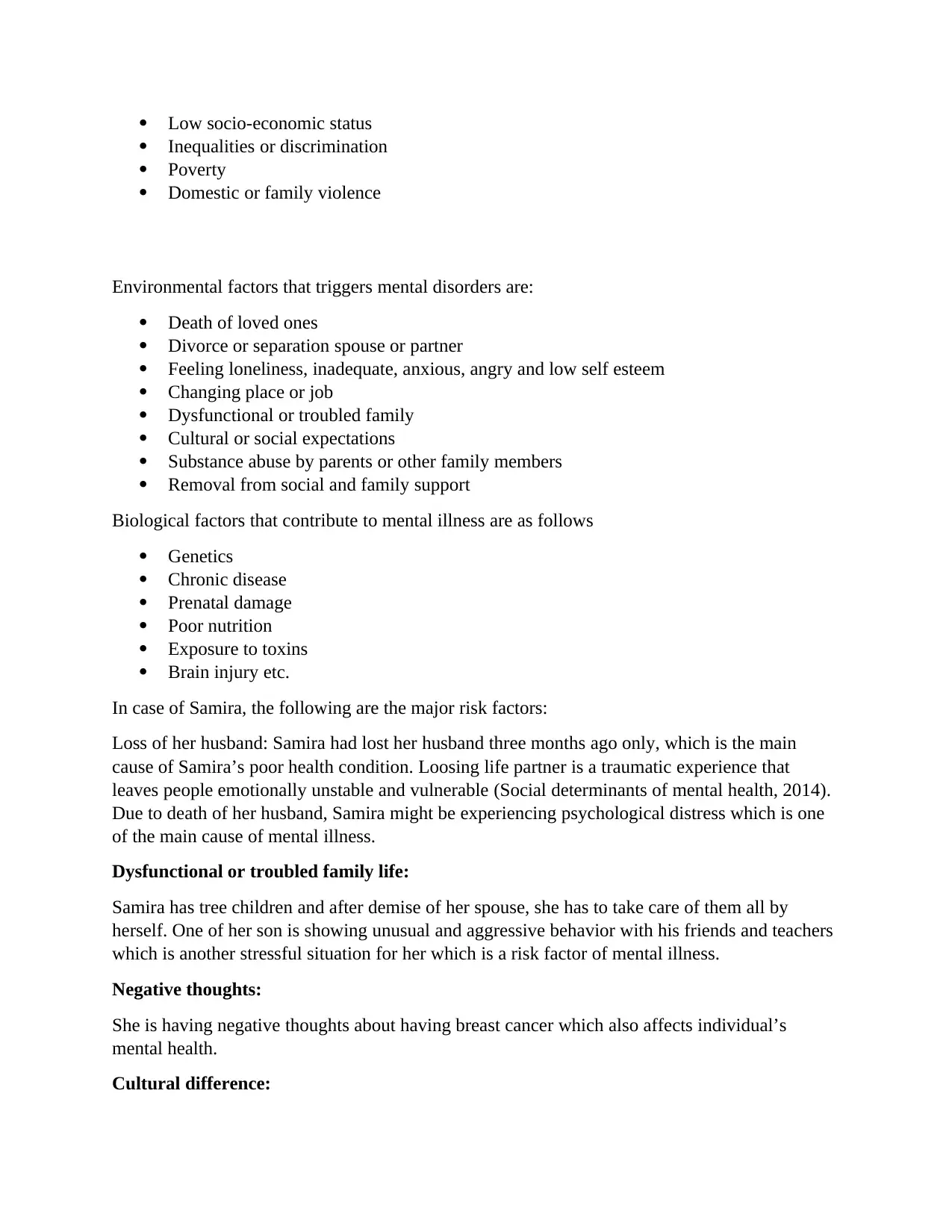
Low socio-economic status
Inequalities or discrimination
Poverty
Domestic or family violence
Environmental factors that triggers mental disorders are:
Death of loved ones
Divorce or separation spouse or partner
Feeling loneliness, inadequate, anxious, angry and low self esteem
Changing place or job
Dysfunctional or troubled family
Cultural or social expectations
Substance abuse by parents or other family members
Removal from social and family support
Biological factors that contribute to mental illness are as follows
Genetics
Chronic disease
Prenatal damage
Poor nutrition
Exposure to toxins
Brain injury etc.
In case of Samira, the following are the major risk factors:
Loss of her husband: Samira had lost her husband three months ago only, which is the main
cause of Samira’s poor health condition. Loosing life partner is a traumatic experience that
leaves people emotionally unstable and vulnerable (Social determinants of mental health, 2014).
Due to death of her husband, Samira might be experiencing psychological distress which is one
of the main cause of mental illness.
Dysfunctional or troubled family life:
Samira has tree children and after demise of her spouse, she has to take care of them all by
herself. One of her son is showing unusual and aggressive behavior with his friends and teachers
which is another stressful situation for her which is a risk factor of mental illness.
Negative thoughts:
She is having negative thoughts about having breast cancer which also affects individual’s
mental health.
Cultural difference:
Inequalities or discrimination
Poverty
Domestic or family violence
Environmental factors that triggers mental disorders are:
Death of loved ones
Divorce or separation spouse or partner
Feeling loneliness, inadequate, anxious, angry and low self esteem
Changing place or job
Dysfunctional or troubled family
Cultural or social expectations
Substance abuse by parents or other family members
Removal from social and family support
Biological factors that contribute to mental illness are as follows
Genetics
Chronic disease
Prenatal damage
Poor nutrition
Exposure to toxins
Brain injury etc.
In case of Samira, the following are the major risk factors:
Loss of her husband: Samira had lost her husband three months ago only, which is the main
cause of Samira’s poor health condition. Loosing life partner is a traumatic experience that
leaves people emotionally unstable and vulnerable (Social determinants of mental health, 2014).
Due to death of her husband, Samira might be experiencing psychological distress which is one
of the main cause of mental illness.
Dysfunctional or troubled family life:
Samira has tree children and after demise of her spouse, she has to take care of them all by
herself. One of her son is showing unusual and aggressive behavior with his friends and teachers
which is another stressful situation for her which is a risk factor of mental illness.
Negative thoughts:
She is having negative thoughts about having breast cancer which also affects individual’s
mental health.
Cultural difference:
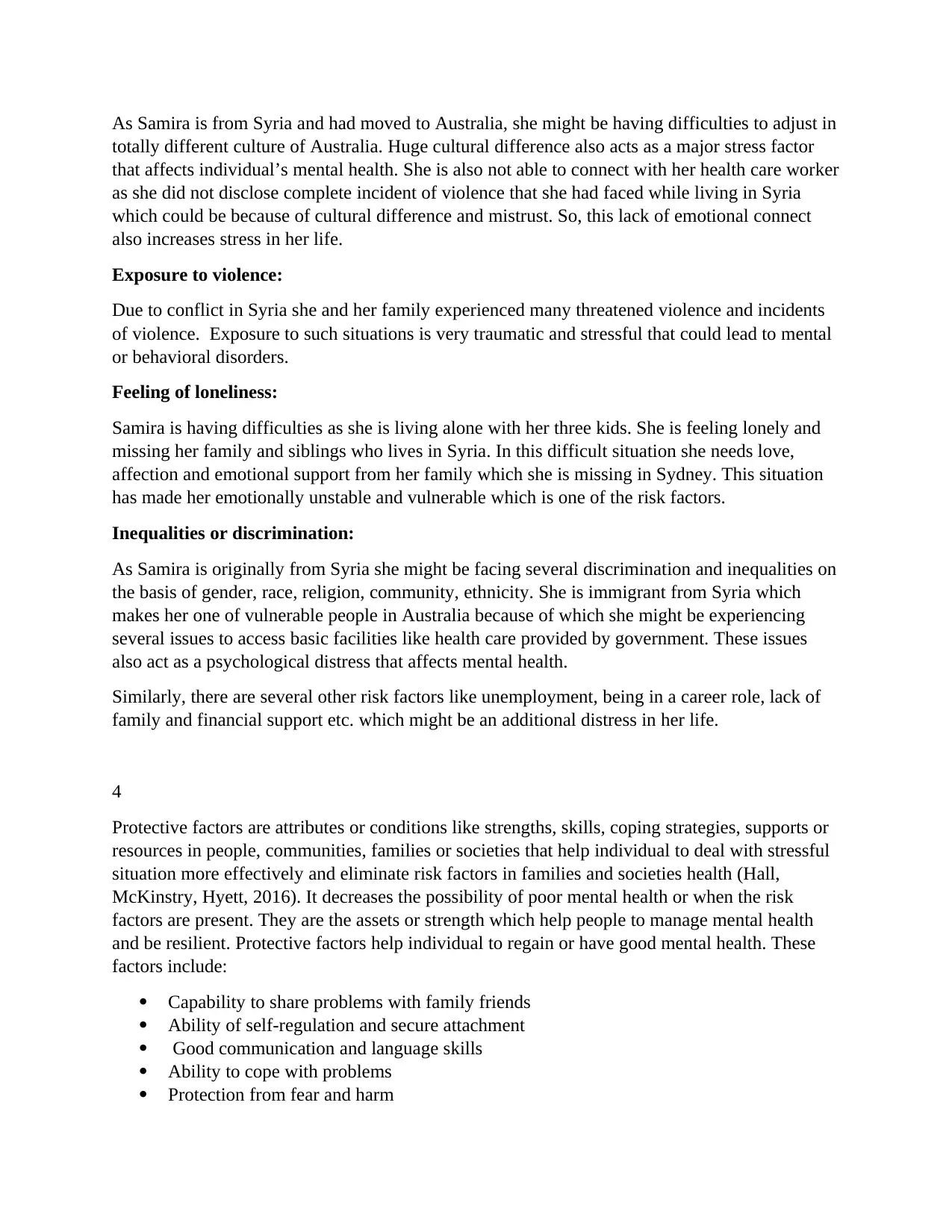
As Samira is from Syria and had moved to Australia, she might be having difficulties to adjust in
totally different culture of Australia. Huge cultural difference also acts as a major stress factor
that affects individual’s mental health. She is also not able to connect with her health care worker
as she did not disclose complete incident of violence that she had faced while living in Syria
which could be because of cultural difference and mistrust. So, this lack of emotional connect
also increases stress in her life.
Exposure to violence:
Due to conflict in Syria she and her family experienced many threatened violence and incidents
of violence. Exposure to such situations is very traumatic and stressful that could lead to mental
or behavioral disorders.
Feeling of loneliness:
Samira is having difficulties as she is living alone with her three kids. She is feeling lonely and
missing her family and siblings who lives in Syria. In this difficult situation she needs love,
affection and emotional support from her family which she is missing in Sydney. This situation
has made her emotionally unstable and vulnerable which is one of the risk factors.
Inequalities or discrimination:
As Samira is originally from Syria she might be facing several discrimination and inequalities on
the basis of gender, race, religion, community, ethnicity. She is immigrant from Syria which
makes her one of vulnerable people in Australia because of which she might be experiencing
several issues to access basic facilities like health care provided by government. These issues
also act as a psychological distress that affects mental health.
Similarly, there are several other risk factors like unemployment, being in a career role, lack of
family and financial support etc. which might be an additional distress in her life.
4
Protective factors are attributes or conditions like strengths, skills, coping strategies, supports or
resources in people, communities, families or societies that help individual to deal with stressful
situation more effectively and eliminate risk factors in families and societies health (Hall,
McKinstry, Hyett, 2016). It decreases the possibility of poor mental health or when the risk
factors are present. They are the assets or strength which help people to manage mental health
and be resilient. Protective factors help individual to regain or have good mental health. These
factors include:
Capability to share problems with family friends
Ability of self-regulation and secure attachment
Good communication and language skills
Ability to cope with problems
Protection from fear and harm
totally different culture of Australia. Huge cultural difference also acts as a major stress factor
that affects individual’s mental health. She is also not able to connect with her health care worker
as she did not disclose complete incident of violence that she had faced while living in Syria
which could be because of cultural difference and mistrust. So, this lack of emotional connect
also increases stress in her life.
Exposure to violence:
Due to conflict in Syria she and her family experienced many threatened violence and incidents
of violence. Exposure to such situations is very traumatic and stressful that could lead to mental
or behavioral disorders.
Feeling of loneliness:
Samira is having difficulties as she is living alone with her three kids. She is feeling lonely and
missing her family and siblings who lives in Syria. In this difficult situation she needs love,
affection and emotional support from her family which she is missing in Sydney. This situation
has made her emotionally unstable and vulnerable which is one of the risk factors.
Inequalities or discrimination:
As Samira is originally from Syria she might be facing several discrimination and inequalities on
the basis of gender, race, religion, community, ethnicity. She is immigrant from Syria which
makes her one of vulnerable people in Australia because of which she might be experiencing
several issues to access basic facilities like health care provided by government. These issues
also act as a psychological distress that affects mental health.
Similarly, there are several other risk factors like unemployment, being in a career role, lack of
family and financial support etc. which might be an additional distress in her life.
4
Protective factors are attributes or conditions like strengths, skills, coping strategies, supports or
resources in people, communities, families or societies that help individual to deal with stressful
situation more effectively and eliminate risk factors in families and societies health (Hall,
McKinstry, Hyett, 2016). It decreases the possibility of poor mental health or when the risk
factors are present. They are the assets or strength which help people to manage mental health
and be resilient. Protective factors help individual to regain or have good mental health. These
factors include:
Capability to share problems with family friends
Ability of self-regulation and secure attachment
Good communication and language skills
Ability to cope with problems
Protection from fear and harm
⊘ This is a preview!⊘
Do you want full access?
Subscribe today to unlock all pages.

Trusted by 1+ million students worldwide
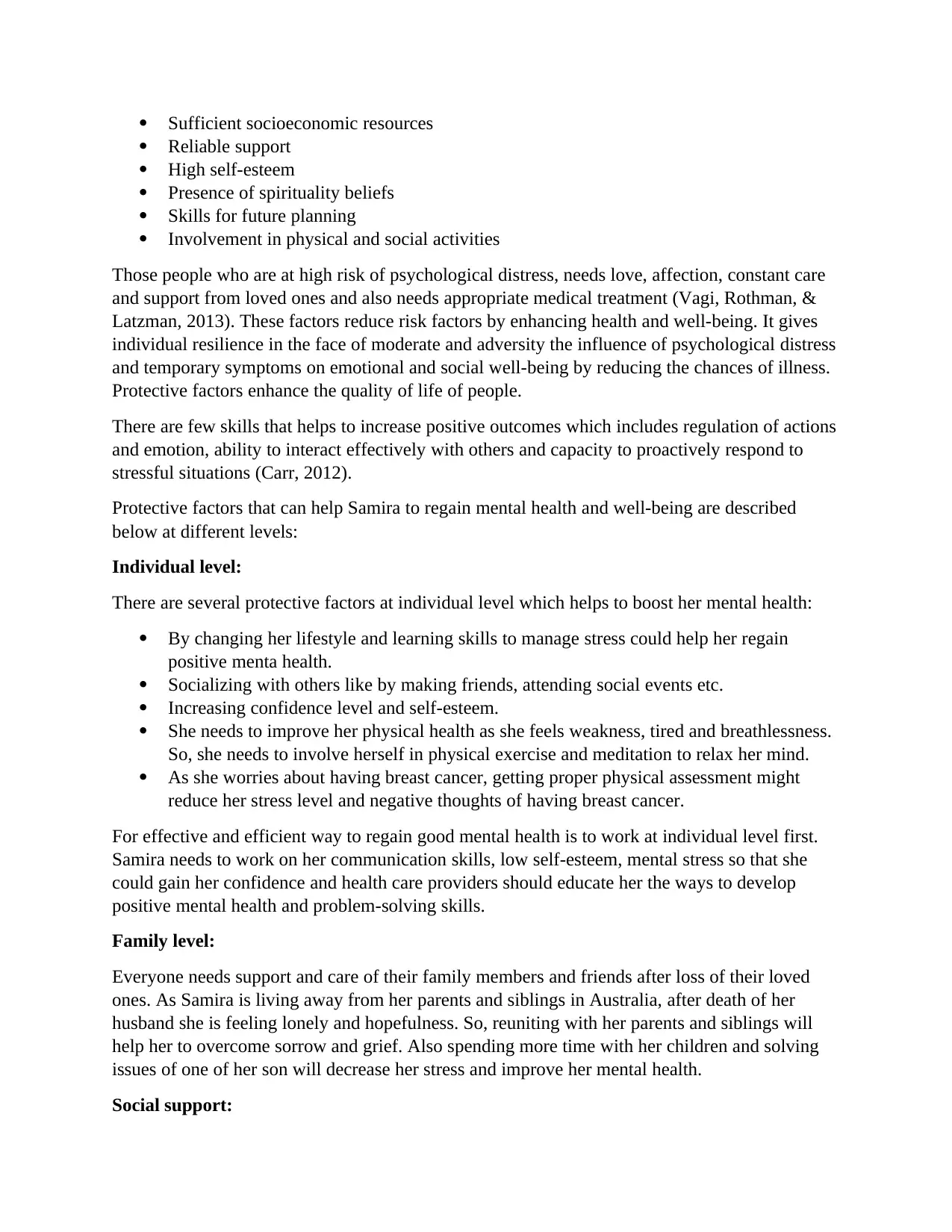
Sufficient socioeconomic resources
Reliable support
High self-esteem
Presence of spirituality beliefs
Skills for future planning
Involvement in physical and social activities
Those people who are at high risk of psychological distress, needs love, affection, constant care
and support from loved ones and also needs appropriate medical treatment (Vagi, Rothman, &
Latzman, 2013). These factors reduce risk factors by enhancing health and well-being. It gives
individual resilience in the face of moderate and adversity the influence of psychological distress
and temporary symptoms on emotional and social well-being by reducing the chances of illness.
Protective factors enhance the quality of life of people.
There are few skills that helps to increase positive outcomes which includes regulation of actions
and emotion, ability to interact effectively with others and capacity to proactively respond to
stressful situations (Carr, 2012).
Protective factors that can help Samira to regain mental health and well-being are described
below at different levels:
Individual level:
There are several protective factors at individual level which helps to boost her mental health:
By changing her lifestyle and learning skills to manage stress could help her regain
positive menta health.
Socializing with others like by making friends, attending social events etc.
Increasing confidence level and self-esteem.
She needs to improve her physical health as she feels weakness, tired and breathlessness.
So, she needs to involve herself in physical exercise and meditation to relax her mind.
As she worries about having breast cancer, getting proper physical assessment might
reduce her stress level and negative thoughts of having breast cancer.
For effective and efficient way to regain good mental health is to work at individual level first.
Samira needs to work on her communication skills, low self-esteem, mental stress so that she
could gain her confidence and health care providers should educate her the ways to develop
positive mental health and problem-solving skills.
Family level:
Everyone needs support and care of their family members and friends after loss of their loved
ones. As Samira is living away from her parents and siblings in Australia, after death of her
husband she is feeling lonely and hopefulness. So, reuniting with her parents and siblings will
help her to overcome sorrow and grief. Also spending more time with her children and solving
issues of one of her son will decrease her stress and improve her mental health.
Social support:
Reliable support
High self-esteem
Presence of spirituality beliefs
Skills for future planning
Involvement in physical and social activities
Those people who are at high risk of psychological distress, needs love, affection, constant care
and support from loved ones and also needs appropriate medical treatment (Vagi, Rothman, &
Latzman, 2013). These factors reduce risk factors by enhancing health and well-being. It gives
individual resilience in the face of moderate and adversity the influence of psychological distress
and temporary symptoms on emotional and social well-being by reducing the chances of illness.
Protective factors enhance the quality of life of people.
There are few skills that helps to increase positive outcomes which includes regulation of actions
and emotion, ability to interact effectively with others and capacity to proactively respond to
stressful situations (Carr, 2012).
Protective factors that can help Samira to regain mental health and well-being are described
below at different levels:
Individual level:
There are several protective factors at individual level which helps to boost her mental health:
By changing her lifestyle and learning skills to manage stress could help her regain
positive menta health.
Socializing with others like by making friends, attending social events etc.
Increasing confidence level and self-esteem.
She needs to improve her physical health as she feels weakness, tired and breathlessness.
So, she needs to involve herself in physical exercise and meditation to relax her mind.
As she worries about having breast cancer, getting proper physical assessment might
reduce her stress level and negative thoughts of having breast cancer.
For effective and efficient way to regain good mental health is to work at individual level first.
Samira needs to work on her communication skills, low self-esteem, mental stress so that she
could gain her confidence and health care providers should educate her the ways to develop
positive mental health and problem-solving skills.
Family level:
Everyone needs support and care of their family members and friends after loss of their loved
ones. As Samira is living away from her parents and siblings in Australia, after death of her
husband she is feeling lonely and hopefulness. So, reuniting with her parents and siblings will
help her to overcome sorrow and grief. Also spending more time with her children and solving
issues of one of her son will decrease her stress and improve her mental health.
Social support:
Paraphrase This Document
Need a fresh take? Get an instant paraphrase of this document with our AI Paraphraser
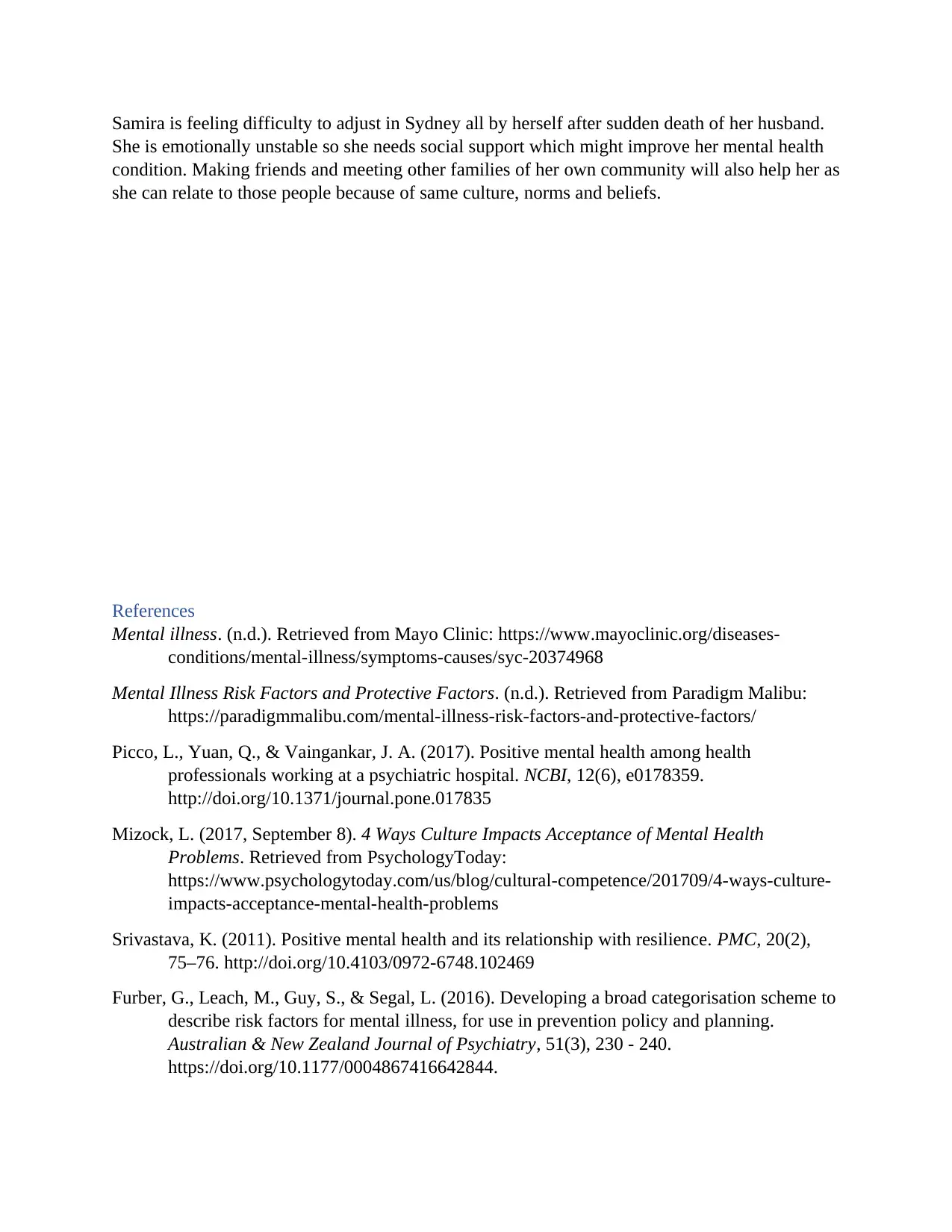
Samira is feeling difficulty to adjust in Sydney all by herself after sudden death of her husband.
She is emotionally unstable so she needs social support which might improve her mental health
condition. Making friends and meeting other families of her own community will also help her as
she can relate to those people because of same culture, norms and beliefs.
References
Mental illness. (n.d.). Retrieved from Mayo Clinic: https://www.mayoclinic.org/diseases-
conditions/mental-illness/symptoms-causes/syc-20374968
Mental Illness Risk Factors and Protective Factors. (n.d.). Retrieved from Paradigm Malibu:
https://paradigmmalibu.com/mental-illness-risk-factors-and-protective-factors/
Picco, L., Yuan, Q., & Vaingankar, J. A. (2017). Positive mental health among health
professionals working at a psychiatric hospital. NCBI, 12(6), e0178359.
http://doi.org/10.1371/journal.pone.017835
Mizock, L. (2017, September 8). 4 Ways Culture Impacts Acceptance of Mental Health
Problems. Retrieved from PsychologyToday:
https://www.psychologytoday.com/us/blog/cultural-competence/201709/4-ways-culture-
impacts-acceptance-mental-health-problems
Srivastava, K. (2011). Positive mental health and its relationship with resilience. PMC, 20(2),
75–76. http://doi.org/10.4103/0972-6748.102469
Furber, G., Leach, M., Guy, S., & Segal, L. (2016). Developing a broad categorisation scheme to
describe risk factors for mental illness, for use in prevention policy and planning.
Australian & New Zealand Journal of Psychiatry, 51(3), 230 - 240.
https://doi.org/10.1177/0004867416642844.
She is emotionally unstable so she needs social support which might improve her mental health
condition. Making friends and meeting other families of her own community will also help her as
she can relate to those people because of same culture, norms and beliefs.
References
Mental illness. (n.d.). Retrieved from Mayo Clinic: https://www.mayoclinic.org/diseases-
conditions/mental-illness/symptoms-causes/syc-20374968
Mental Illness Risk Factors and Protective Factors. (n.d.). Retrieved from Paradigm Malibu:
https://paradigmmalibu.com/mental-illness-risk-factors-and-protective-factors/
Picco, L., Yuan, Q., & Vaingankar, J. A. (2017). Positive mental health among health
professionals working at a psychiatric hospital. NCBI, 12(6), e0178359.
http://doi.org/10.1371/journal.pone.017835
Mizock, L. (2017, September 8). 4 Ways Culture Impacts Acceptance of Mental Health
Problems. Retrieved from PsychologyToday:
https://www.psychologytoday.com/us/blog/cultural-competence/201709/4-ways-culture-
impacts-acceptance-mental-health-problems
Srivastava, K. (2011). Positive mental health and its relationship with resilience. PMC, 20(2),
75–76. http://doi.org/10.4103/0972-6748.102469
Furber, G., Leach, M., Guy, S., & Segal, L. (2016). Developing a broad categorisation scheme to
describe risk factors for mental illness, for use in prevention policy and planning.
Australian & New Zealand Journal of Psychiatry, 51(3), 230 - 240.
https://doi.org/10.1177/0004867416642844.
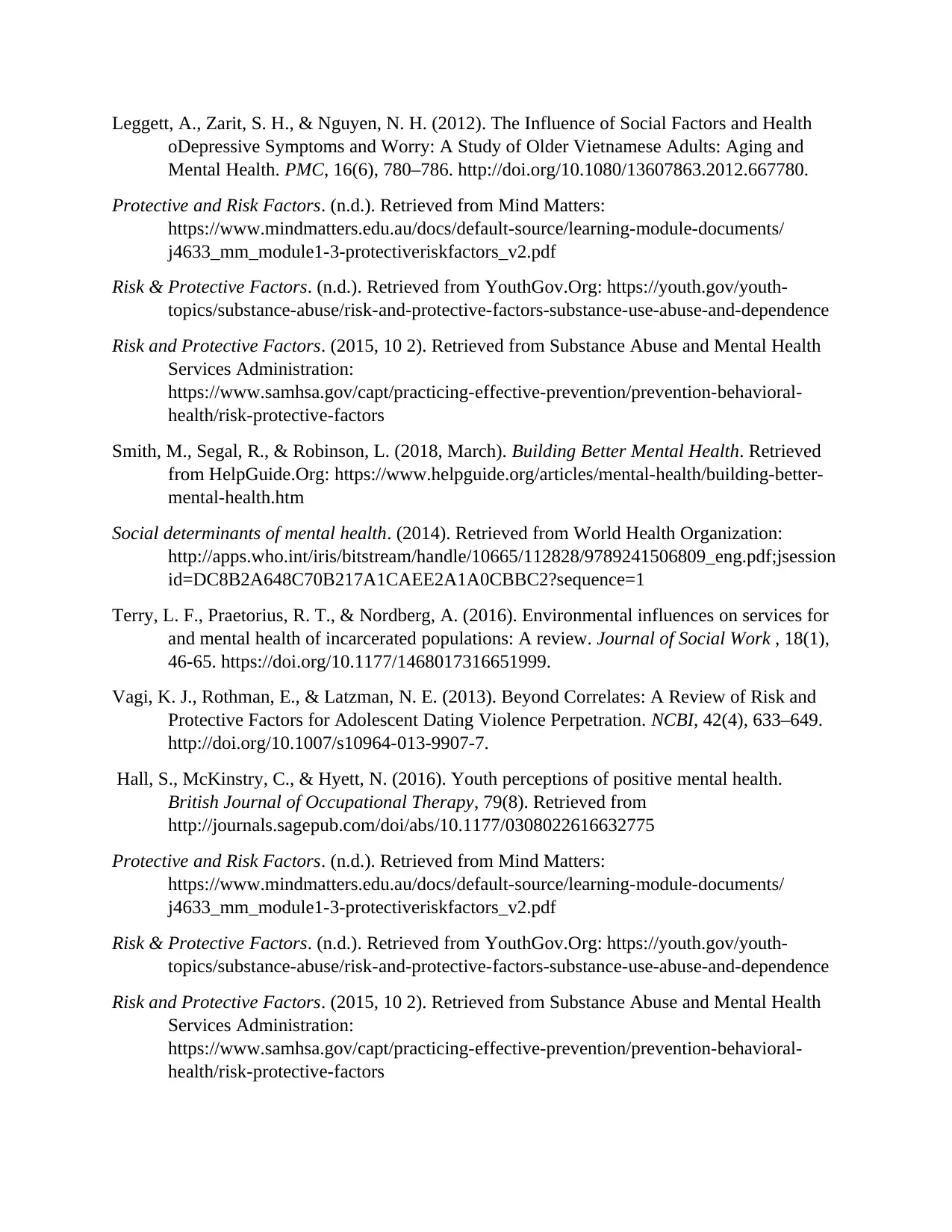
Leggett, A., Zarit, S. H., & Nguyen, N. H. (2012). The Influence of Social Factors and Health
oDepressive Symptoms and Worry: A Study of Older Vietnamese Adults: Aging and
Mental Health. PMC, 16(6), 780–786. http://doi.org/10.1080/13607863.2012.667780.
Protective and Risk Factors. (n.d.). Retrieved from Mind Matters:
https://www.mindmatters.edu.au/docs/default-source/learning-module-documents/
j4633_mm_module1-3-protectiveriskfactors_v2.pdf
Risk & Protective Factors. (n.d.). Retrieved from YouthGov.Org: https://youth.gov/youth-
topics/substance-abuse/risk-and-protective-factors-substance-use-abuse-and-dependence
Risk and Protective Factors. (2015, 10 2). Retrieved from Substance Abuse and Mental Health
Services Administration:
https://www.samhsa.gov/capt/practicing-effective-prevention/prevention-behavioral-
health/risk-protective-factors
Smith, M., Segal, R., & Robinson, L. (2018, March). Building Better Mental Health. Retrieved
from HelpGuide.Org: https://www.helpguide.org/articles/mental-health/building-better-
mental-health.htm
Social determinants of mental health. (2014). Retrieved from World Health Organization:
http://apps.who.int/iris/bitstream/handle/10665/112828/9789241506809_eng.pdf;jsession
id=DC8B2A648C70B217A1CAEE2A1A0CBBC2?sequence=1
Terry, L. F., Praetorius, R. T., & Nordberg, A. (2016). Environmental influences on services for
and mental health of incarcerated populations: A review. Journal of Social Work , 18(1),
46-65. https://doi.org/10.1177/1468017316651999.
Vagi, K. J., Rothman, E., & Latzman, N. E. (2013). Beyond Correlates: A Review of Risk and
Protective Factors for Adolescent Dating Violence Perpetration. NCBI, 42(4), 633–649.
http://doi.org/10.1007/s10964-013-9907-7.
Hall, S., McKinstry, C., & Hyett, N. (2016). Youth perceptions of positive mental health.
British Journal of Occupational Therapy, 79(8). Retrieved from
http://journals.sagepub.com/doi/abs/10.1177/0308022616632775
Protective and Risk Factors. (n.d.). Retrieved from Mind Matters:
https://www.mindmatters.edu.au/docs/default-source/learning-module-documents/
j4633_mm_module1-3-protectiveriskfactors_v2.pdf
Risk & Protective Factors. (n.d.). Retrieved from YouthGov.Org: https://youth.gov/youth-
topics/substance-abuse/risk-and-protective-factors-substance-use-abuse-and-dependence
Risk and Protective Factors. (2015, 10 2). Retrieved from Substance Abuse and Mental Health
Services Administration:
https://www.samhsa.gov/capt/practicing-effective-prevention/prevention-behavioral-
health/risk-protective-factors
oDepressive Symptoms and Worry: A Study of Older Vietnamese Adults: Aging and
Mental Health. PMC, 16(6), 780–786. http://doi.org/10.1080/13607863.2012.667780.
Protective and Risk Factors. (n.d.). Retrieved from Mind Matters:
https://www.mindmatters.edu.au/docs/default-source/learning-module-documents/
j4633_mm_module1-3-protectiveriskfactors_v2.pdf
Risk & Protective Factors. (n.d.). Retrieved from YouthGov.Org: https://youth.gov/youth-
topics/substance-abuse/risk-and-protective-factors-substance-use-abuse-and-dependence
Risk and Protective Factors. (2015, 10 2). Retrieved from Substance Abuse and Mental Health
Services Administration:
https://www.samhsa.gov/capt/practicing-effective-prevention/prevention-behavioral-
health/risk-protective-factors
Smith, M., Segal, R., & Robinson, L. (2018, March). Building Better Mental Health. Retrieved
from HelpGuide.Org: https://www.helpguide.org/articles/mental-health/building-better-
mental-health.htm
Social determinants of mental health. (2014). Retrieved from World Health Organization:
http://apps.who.int/iris/bitstream/handle/10665/112828/9789241506809_eng.pdf;jsession
id=DC8B2A648C70B217A1CAEE2A1A0CBBC2?sequence=1
Terry, L. F., Praetorius, R. T., & Nordberg, A. (2016). Environmental influences on services for
and mental health of incarcerated populations: A review. Journal of Social Work , 18(1),
46-65. https://doi.org/10.1177/1468017316651999.
Vagi, K. J., Rothman, E., & Latzman, N. E. (2013). Beyond Correlates: A Review of Risk and
Protective Factors for Adolescent Dating Violence Perpetration. NCBI, 42(4), 633–649.
http://doi.org/10.1007/s10964-013-9907-7.
Hall, S., McKinstry, C., & Hyett, N. (2016). Youth perceptions of positive mental health.
British Journal of Occupational Therapy, 79(8). Retrieved from
http://journals.sagepub.com/doi/abs/10.1177/0308022616632775
Protective and Risk Factors. (n.d.). Retrieved from Mind Matters:
https://www.mindmatters.edu.au/docs/default-source/learning-module-documents/
j4633_mm_module1-3-protectiveriskfactors_v2.pdf
Risk & Protective Factors. (n.d.). Retrieved from YouthGov.Org: https://youth.gov/youth-
topics/substance-abuse/risk-and-protective-factors-substance-use-abuse-and-dependence
Risk and Protective Factors. (2015, 10 2). Retrieved from Substance Abuse and Mental Health
Services Administration:
https://www.samhsa.gov/capt/practicing-effective-prevention/prevention-behavioral-
health/risk-protective-factors
⊘ This is a preview!⊘
Do you want full access?
Subscribe today to unlock all pages.

Trusted by 1+ million students worldwide
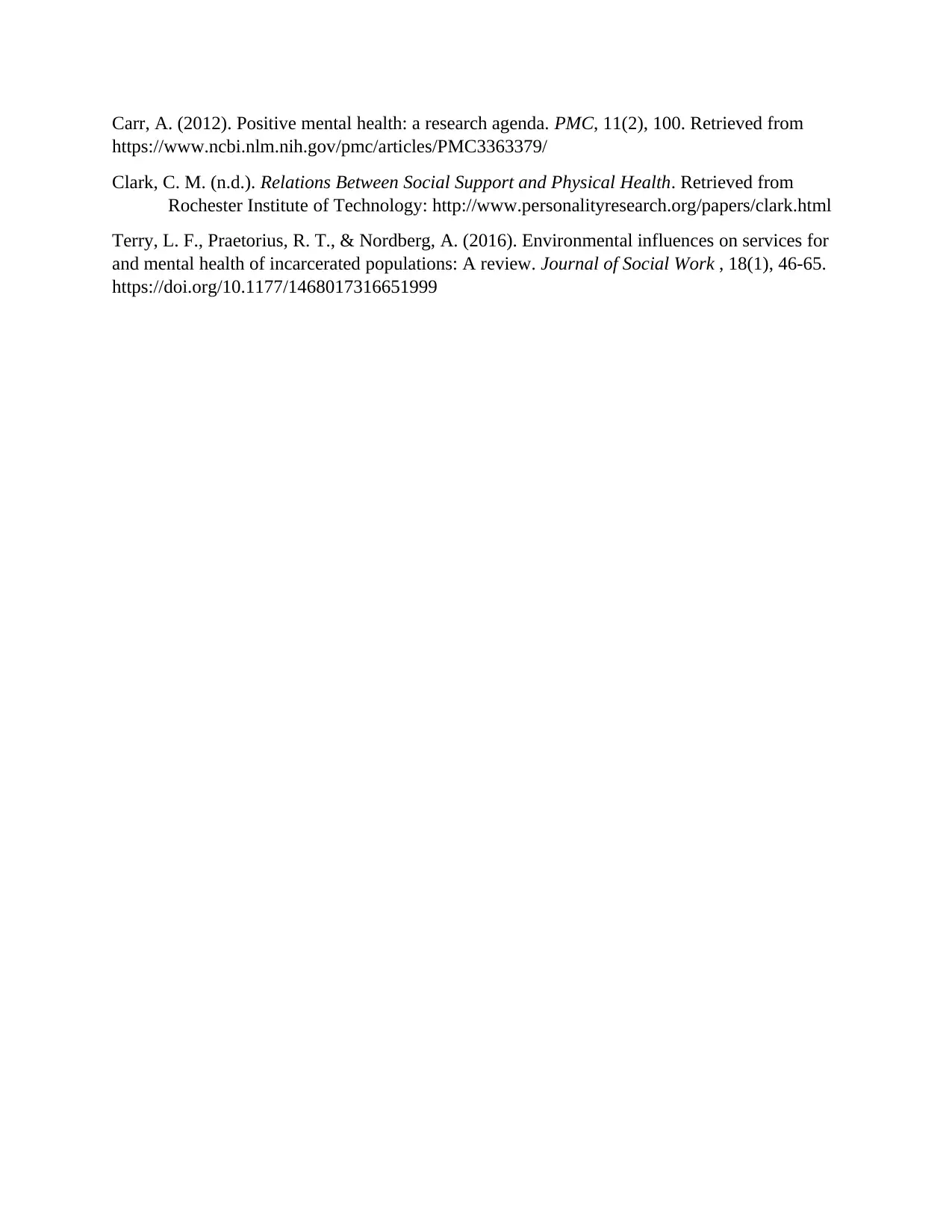
Carr, A. (2012). Positive mental health: a research agenda. PMC, 11(2), 100. Retrieved from
https://www.ncbi.nlm.nih.gov/pmc/articles/PMC3363379/
Clark, C. M. (n.d.). Relations Between Social Support and Physical Health. Retrieved from
Rochester Institute of Technology: http://www.personalityresearch.org/papers/clark.html
Terry, L. F., Praetorius, R. T., & Nordberg, A. (2016). Environmental influences on services for
and mental health of incarcerated populations: A review. Journal of Social Work , 18(1), 46-65.
https://doi.org/10.1177/1468017316651999
https://www.ncbi.nlm.nih.gov/pmc/articles/PMC3363379/
Clark, C. M. (n.d.). Relations Between Social Support and Physical Health. Retrieved from
Rochester Institute of Technology: http://www.personalityresearch.org/papers/clark.html
Terry, L. F., Praetorius, R. T., & Nordberg, A. (2016). Environmental influences on services for
and mental health of incarcerated populations: A review. Journal of Social Work , 18(1), 46-65.
https://doi.org/10.1177/1468017316651999
1 out of 10
Related Documents
Your All-in-One AI-Powered Toolkit for Academic Success.
+13062052269
info@desklib.com
Available 24*7 on WhatsApp / Email
![[object Object]](/_next/static/media/star-bottom.7253800d.svg)
Unlock your academic potential
Copyright © 2020–2025 A2Z Services. All Rights Reserved. Developed and managed by ZUCOL.





